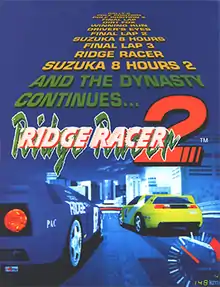Ridge Racer 2
Ridge Racer 2[lower-alpha 1] is an arcade racing game that was released by Namco in 1994 for their System 22 hardware. Despite its name, Ridge Racer 2 is more of an updated version of Ridge Racer (which had been released in the previous year), than an actual sequel.
| Ridge Racer 2 | |
|---|---|
 | |
| Developer(s) | Namco |
| Publisher(s) | Namco |
| Series | Ridge Racer |
| Platform(s) | Arcade |
| Release | Arcade |
| Genre(s) | Racing |
| Mode(s) | Single-player, multiplayer |
| Arcade system | Namco System 22 |
Gameplay
The gameplay is very much like that of the original. However, unlike the vanilla version of Ridge Racer (which was a single-player game), in Ridge Racer 2 up to eight players can play simultaneously when four two-player cabinets are linked together. A player's number determines their car.
There also are six new songs, including remixed ones from the original, that can be selected with the gear shifter at the start. The enormous television screen above the entrance to the first tunnel shows footage from Namco's 1979 title Galaxian (in the original, it was playing Mappy). All the billboards are for earlier Namco games, there is a rear-view mirror at the top of the screen, so a player can see other cars coming from behind). There is also a change in daylight from day to night (a car driven into the track's tunnel during the day will come out the other end at night).
Legacy
In 1995 Ridge Racer/Ridge Racer 2 was followed by two true sequels. An arcade sequel, named Rave Racer, which was developed for Namco's System 22 hardware and a home console sequel, named Ridge Racer Revolution, for the PlayStation (which inherited Ridge Racer 2's soundtrack ).
Reception
In Japan, Game Machine listed Ridge Racer 2 on their August 15, 1994 issue as being the fourth most-successful upright arcade game of the year.[1] Next Generation reviewed the arcade version of the game, rating it four stars out of five, and stated that "eight-user multi-player link-up has been added to enable Ridge Racer 2 to compete on equal footing with Sega's Daytona USA and Namco's new Ace Driver."[2]
References
Footnotes
- "Game Machine's Best Hit Games 25 - アップライト, コックピット型TVゲーム機 (Upright/Cockpit Videos)". Game Machine (in Japanese). No. 478. Amusement Press, Inc. 15 August 1994. p. 25.
- "Finals". Next Generation. No. 1. Imagine Media. January 1995. p. 105.
External links
- Ridge Racer 2 at the Killer List of Videogames
- Ridge Racer 2 at the Arcade History database